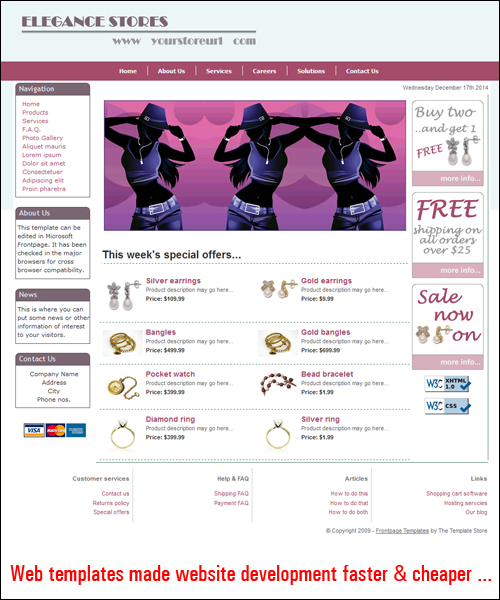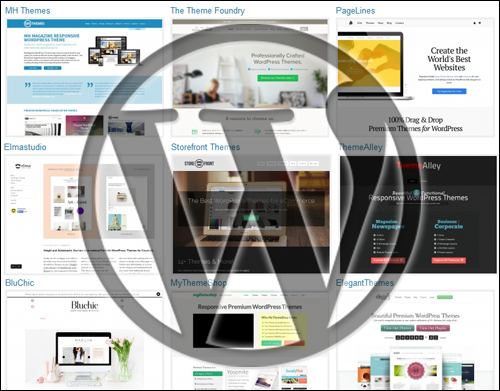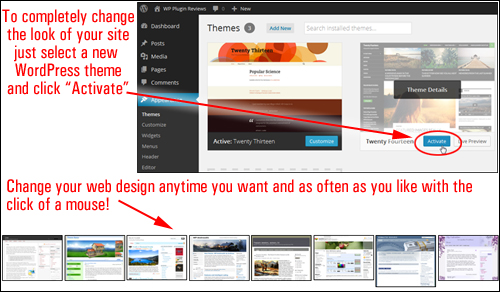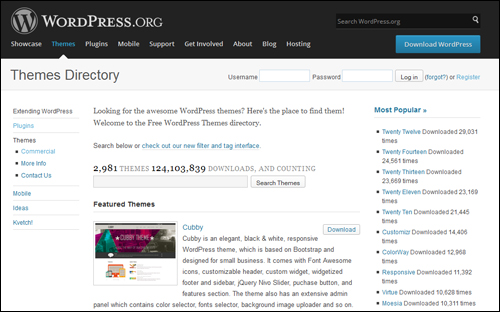 Advanced content publishing tools like the WordPress CMS have effectively improved web design and web development for users.
Advanced content publishing tools like the WordPress CMS have effectively improved web design and web development for users.
This is a great thing for business owners planning on getting a website that they can manage.
Before blogging and the introduction of user-friendly CMS applications, if you wanted a website, you had to wait until both the web development and website design processes were fully completed. This could take weeks, even months!
The introduction of WordPress themes have changed all this. In this post, we explore what themes are, how WordPress themes save you and your business money on web development costs, and how themes make it easy to customize your site.
A New Development In Web Design
More website owners have been benefiting from a revolutionary change in web design that started several years ago. If you own a small business, you will want to learn more about this, because it could save your business thousands of dollars on web development and website design costs.
In a nutshell, here’s what happened before CMS solutions like WordPress came along:
First, you would meet with a web development company or designer for a brief. Next, the “web design” would be discussed and agreed upon. This meant spending time with a professional website designer going over areas of your website such as the, colours, styles, graphic elements, content, etc.
Each page of your website then had to be individually created with all of your elements and scripts coded around your page content. The pages were then assembled into a website using links and custom coded navigation menus and uploaded to your server, together with every other file needed to make your site work – script libraries, images, media elements, etc.

(image source:adobe.com)
Only after everything had been tested and performed how it was intended to (and looking the way a client had wanted it to look), was the site deemed to have been finished and ready for delivery.
The next step in the evolution of business website design was the introduction of “website templates”. Website templates allow the ”look and feel” of the web site to be worked on separately from content on the page. The introduction of templates helped to make site creation faster and resulted in lowered production costs. This also enabled web development companies to service business clients with less money to spend on marketing …

(image source: www.dreamweaver-templates.org)
As more web site development companies started using “template-based” websites, web templates started being developed that could provide different custom options, like the option to choose different colors, styles, layouts
As websites and web building tools evolved, web templates also started to evolve into website templating ”systems”, letting users and website designers manage the visual components of their site.
Then, a “blogging” tool called WordPress was developed and helped to start a new digital publishing revolution …

(WordPress – A Content Publishing Revolution)
To learn more about content management systems and the benefits of the WordPress CMS, see the tutorial below:
About WordPress Themes
WordPress themes push the concept of a website template system even further.
The WP theme system controls and integrates every aspect of your web design. It lets you add a “skin” over your entire site similarly to what a web template system does but it also also gives you complete control over the management and customization aspects of the site’s template options.
As stated in the official WordPress site …
A WordPress Theme is a collection of files that work together to produce a graphical interface with an underlying unifying design for a weblog. These files are called template files. A Theme modifies the way the site is displayed, without modifying the underlying software. Themes may include customized template files, image files (*.jpg, *.gif), style sheets (*.css), custom Pages, as well as any necessary code files (*.php).
(source: WordPress.org)
As stated in the quote above, one of the unique and revolutionary features of a WordPress theme is that the way your web site appears to visitors on the outside is kept independent of the management of your content.
In simple terms, what this means is that you can change the look and feel of your website as often as you like without modifying your website’s content and all the functionality you’ve built into it. For example, if you have configured WP site for e-commerce, changing the entire look of the site with another theme won’t affect the content or the functionality of the website. All e-commerce features, settings and product information will remain unaffected, but your site will look completely different.
Why is this such great news for business owners?
Because when you use WordPress, you no longer need to wait until your site’s web design is completed. You can get your website built simply and start with any WordPress theme you like, and then completely change the look, feel and design of your site in mere minutes, whenever you decide … and as often as you like!
Even better, you can easily install a theme on your WP site without requiring website code programming skills. Simply choose a WordPress theme you want, upload it to your site and activate it. WordPress allows you to change your web design and customize elements like header images, page layout, styling options and more in less than a few minutes …

As WordPress is distributed as open source software, website designers anywhere in the world can design themes specifically for the WordPress CMS platform using the WP template system.
This means that loads of great WP themes are made available to WordPress users. Themes are usually distributed for Free under the terms of the GNU General Public License, or sold as Premium (paid) WP themes.
The WordPress development team keeps a FREE theme directory which allows WordPress users to download, access and install thousands of excellent web templates at $0 cost …

(WordPress.org – Themes Directory)
As the popularity of WordPress increases, more designers are now starting to create themes for a wider range of uses.
WP themes range from simple-looking, to artsy designs that are quite impressive and would normally cost hundreds or even thousands of dollars to commission. Surprisingly, most WP themes are really inexpensive to buy.
You can see a number of WP theme galleries containing many examples of great premium themes in this article:

(Browse Thousands Of FREE WordPress Themes!)
Themes – Benefits And Advantages
Here are just a few of the benefits and advantages of choosing WordPress themes over using web building tools that require traditional website design:
Ready To Use In Very Little Time
WP themes are really easy to install on your site. Simply upload a zip file containing the plugin to your Plugin folder via your WP administrator area and activate. Even easier still, you can install any of the themes listed in the WordPress theme directory at WordPress.org) directly from your WordPress site’s admin area.

Additionally,
- WordPress has a growing online community of professional website designers who, collectively, make thousands of professional WP Themes available to WordPress users. Many of these themes are completely free to use!
- Themes give sites a unified and consistent design across all the blog’s elements, i.e. pages, headers, footers, layout, etc …
- A “theme” works independently of your digital content. This allows you replace WordPress themes as often as you like without disturbing your website’s content.
- Many WordPress themes provide additional features and settings that let you easily customize your site’s layout and design properties and create a unique look to suit your preferences.
- Many themes are built using a framework that enables you to upgrade themes to newer theme versions without losing any unique customizations (e.g. CSS styles)
- WordPress allows you to search, import and install WordPress Themes automatically right within your site’s administration interface.
- WordPress themes helps you save hundreds of dollars on website development costs. Free WP themes cost nothing and most “Premium”themes are normally quite affordable.
About Responsive WordPress Theme Design
Many WP theme developers are now creating themes that incorporate “responsive” design protocols.
A responsive theme allows websites to automatically reconfigure the layout to display smoothly over different screen sizes and resolutions, as well as different devices (e.g. laptops, tablets, mobile phones, etc.) …

A responsive theme is also optimized for different types of devices. Users can scroll, read and load a site on most if not all device browsers without having to readjust their browser settings, or requiring the website owner to install additional themes.
Note: When selecting, WordPress themes, we strongly recommend choosing a responsive WordPress theme. Not only will the theme ensure that your website works on all devices, it also means that the theme is newer than non-responsive themes and therefore complies with the latest standards of website design coding.
We hope that this basic overview has helped you gain a better understanding of WP themes, what WordPress themes are, how they help you save money, and how WP themes make customizing web sites easy.
To learn where to find the best WordPress themes for your blog, see this post: How To Find The Best Free And Paid WordPress Themes On The Web.
***
"I was absolutely amazed at the scope and breadth of these tutorials! The most in-depth training I have ever received on any subject!" - Myke O'Neill, DailyGreenPost.com
***